|
|
|
| Application of the geochemical block method to the assessment of copper resources in Ethiopia |
XIANG Wen-Shuai1( ), BAI Yang2( ), BAI Yang2( ), JIANG Jun-Sheng1, LEI Yi-Jun1, HUNDIE Melka3, SISAY Degu3, ZHANG Yuan-Pei2, WU Ying2, ZHENG Xiong-Wei2 ), JIANG Jun-Sheng1, LEI Yi-Jun1, HUNDIE Melka3, SISAY Degu3, ZHANG Yuan-Pei2, WU Ying2, ZHENG Xiong-Wei2 |
1. Wuhan Center, China Geological Survey,Central South China Innovation Center for Geosciences, Wuhan 430205, China
2. Geophysical Exploration Brigade, Hubei Geological Bureau, Wuhan 430056, China
3. Ethiopian Geological Survey, Addis Ababa 999047, Ethiopia |
|
|
|
|
Abstract Low-density geochemical mapping is characterized by high order streams to be sampled and a large coverage area and can be used to effectively trace geochemical blocks with high metal contents. Based on the 1:1,000,000 low-density geochemical mapping data of Ethiopia and the processing of the testing data of Cu in the original stream sediments, this study calculated the anomaly threshold of Cu at 37×10-6 through iterative deletion. Then, this study delineated three geochemical blocks and two regional anomalies with 37×10-6, 42×10-6, 47×10-6, 52×10-6, 59×10-6, and 66×10-6 as grading intervals. It calculated the mineralization coefficient of Cu ore bodies in the study area at 0.055% by referencing the known reserves of Cu deposits in geochemical blocks with a high level of copper exploration in the same metallogenic belt. Moreover, this study estimated the Cu resources in the study area at 2,600,000 t based on a rock mass thickness of 1,000 m. By combining the analysis of metallogenic geological conditions, this study determined that the zones where geochemical blocks nos. 2, 3, and 4 are located can be considered key metallogenic prospect areas for further detailed exploration.
|
|
Received: 19 April 2022
Published: 11 October 2023
|
|
|
|
|
|
15])
">

|
Brief geologyand sample point map of Ethiopia-Eritrea(revised according to reference [15])
|
20])
">

|
Brief geology and mineral map of Eritrea-North Ethiopia(revised according to reference [20])
|

| 元素 | 数据量 | 最小值/10-6 | 最大值/10-6 | 四分位值/10-6 | 平均值/10-6 | 标准差/10-6 | | 25% | 50% | 75% | | Cu | 839 | 1.9 | 137.4 | 12.7 | 20.5 | 31.4 | 25.1 | 17.7 | | 元素 | 剔除3倍离差后 | 浓度分带/10-6 | | 平均值/10-6 | 标准差/10-6 | 1级 | 2级 | 3级 | 4级 | 5级 | 6级 | | Cu | 22.9 | 14.1 | 37 | 42 | 47 | 52 | 59 | 66 |
|
Processed geochemical statistic characteristics of copper and content level of the geochemical blocks
|
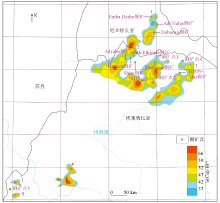
|
Distribution of copper geochemical blocks and regional anomalies in study area
|
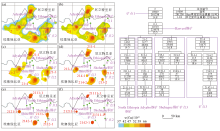
|
Internal structure of No.2 copper geochemical block
(a~f is first to sixth level content, including 1,1,4,4,4,4 child geochemical blocks respectively)
|
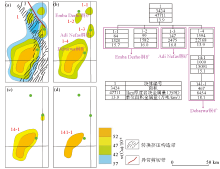
|
Internal structure and Family tree diagram of No.1 copper geochemical block
(a~d is first to fourth level content,includig 1,4,1,1 child geochemical blocks respectively)
|
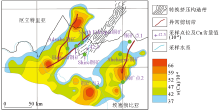
|
No.2 geochemical block and brief regional geology and mineral map
|

| 编号 | 面积/
km2 | Cu最大
值/10-6 | Cu最小
值/10-6 | Cu平均
值/10-6 | Cu供应
量/万t | | 1 | 3424 | 89.4 | 18.3 | 51.8(n=20) | 47711 | | 2 | 19009 | 137.4 | 23.6 | 55(n=53) | 281238 | | 3 | 9529 | 88.4 | 18.4 | 47.3(n=19) | 121244 | | 4 | 2592 | 78.2 | 40.8 | 63.5(n=7) | 44275 |
|
Statistic characteristic of copper geochemical blocks
|

| 编号 | Cu面积/
km2 | Cu最大
值/10-6 | Cu最小
值/10-6 | 平均值/
10-6 | Cu供应
量/万t | | I | 458 | 76.7 | 48.7 | 62.7(n=2) | 7725 | | II | 359 | 66.9 | 43.1 | 53.9(n=4) | 5205 |
|
Statistic characteristic of copper regional geochemical anomalies
|

| 编号 | 面积/
km2 | 矿床 | Cu供应
量/万t | 探明
Cu资源
量/万t | 预测
Cu资源
量/万t | | 1 | 3424 | Emba Derho铜矿、Debarwa铜矿、Adi Nefas铜矿 | 47711 | 52 | 52 | | 2 | 19009 | Adyabo铜矿、Harves铜矿、Shire铜矿、North Ethiopia铜矿、Shehagne铜矿 | 281238 | | 155 | | 3 | 9529 | Tigray-Afar铜矿 | 121244 | | 67 | | 4 | 2592 | | 44275 | | 24 | | I | 458 | | 7725 | | 8 | | II | 359 | | 5205 | | 6 | | 总计 | 35371 | | 507398 | | 312 |
|
Estimated potential copper resources of copper geochemical blocks and regional anomalies
|
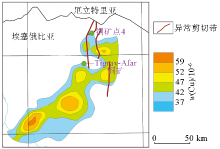
|
No.3 geochemical block and brief regional geology and mineral map
|
| [1] |
刘大文. 地球化学块体的概念及其研究意义[J]. 地球化学, 2002, 31(6):539-548.
|
| [1] |
Liu D W. Development and significance of geochemical blocks[J]. Geochimica, 2002, 31(6):539-548.

|
| [2] |
刘大文, 谢学锦. 基于地球化学块体概念的中国锡资源潜力评价[J]. 中国地质, 2005, 32(1):25-32.
|
| [2] |
Liu D W, Xie X J. Evaluation of China's tin resources potential based on the geochemical block concept[J]. Geology in China, 2005, 32(1):25-32.
|
| [3] |
王学求, 申伍军, 张必敏, 等. 地球化学块体与大型矿集区的关系——以东天山为例[J]. 地学前缘, 2007, 14(5):116-123.
|
| [3] |
Wang X Q, Shen W J, Zhang B M, et al. Relationship of grochemical blocks and ore districts: Examples from Eastern Tianshan metallogenic belt,Xinjiang,China[J]. Earth Science Frontiers, 2007, 14(5):116-123.

|
| [4] |
周洲强, 李伟, 钱建明. 浙江省地球化学块体特征及找矿意义[J]. 资源调查与环境, 2015, 36(1):36-41.
|
| [4] |
Zhou Z Q, Li W, Qian J M. Characteristics of geochemical blocks and ore prospecting implications in Zhejiang Province[J]. Resources Survey and Environment, 2015, 36(1):36-41.
|
| [5] |
张红涛. 用地球化学块体法评价辽宁省钼矿资源潜力[J]. 现代矿业, 2016, 572(12):96-107.
|
| [5] |
Zhang H T. Molybdenum resources potential of Liaoning Province based on geochemical block method[J]. Modern Mining, 2016, 572(12):96-107.
|
| [6] |
范堡程, 张晶, 孟广路. 帕米尔构造结锂矿资源潜力评价——基于1:100万地球化学调查[J]. 西北地质, 2022, 55(1):156-166.
|
| [6] |
Fan B C, Zhang J, Meng G L. An assessment of lithium resource potentiality in Pamir syntax—Based on 1:1 million scale of geochemical survey[J]. Northwestern Geology, 2022, 55(1):156-166.
|
| [7] |
向文帅, 姜军胜, 赵凯. 应用地球化学块体法评价厄立特里亚金矿资源潜力[J]. 中国矿业, 2019, 28(12):176-182.
|
| [7] |
Xiang W S, Jiang J S, Zhao K. The application of geochemical blocks methods to gold resource assessment in Eritrea[J]. China Mining Magazine, 2019, 28(12):176-182.
|
| [8] |
谢学锦, 刘大文, 向运川, 等. 地球化学块体——概念和方法学的发展[J]. 中国地质, 2002, 29(3):225-233.
|
| [8] |
Xie X J, Liu D W, Xiang Y C, et al. Geochemical blocks:Development of concept and methodology[J]. Geology in China, 2002, 29(3):225-233.
|
| [9] |
刘大文. 地球化学块体理论与方法技术应用于矿产资源评价的研究[D]. 北京: 中国地质科学院, 2002.
|
| [9] |
Liu D W. National mineral resources assessment,using geochemical block concept[D]. Beijing: Chinese Academy of Geological Sciences, 2002.
|
| [10] |
梁学玉. 埃塞俄比亚纳格莱Ⅱ地球化学异常特征与评价[D]. 成都: 成都理工大学, 2016.
|
| [10] |
Liang X Y. Characteristics and evaluation of geochemical anomaly in NegeleⅡ,Ethiopia[D]. Chengdu: Chengdu University of Technology, 2016.
|
| [11] |
高长亮, 党万民, 田绍喜, 等. 埃塞俄比亚地质特征与矿产概况[J]. 山东国土资源, 2010, 26(11):19-27.
|
| [11] |
Gao C L, Dang W M, Tian S X, et al. Geological characteristics and general condition of mineral resources in Ethiopia[J]. Shandong Land and Resources, 2010, 26(11):19-27.
|
| [12] |
Hamimi Z, Fowler A R, Liégeois J P, et al. The geology of the Arabian-Nubian shield[M]. Cham:Springer, 2021.
|
| [13] |
韩世礼. 埃塞俄比亚施瑞地区VMS型矿床成矿机制及成矿规律研究[D]. 长沙: 中南大学, 2013.
|
| [13] |
Han S L. Study on metallogenic mechanism and regularities of VMS deposit from Shire region in Ethiopia[D]. Changsha: Central South University, 2013.
|
| [14] |
白丽伟. 埃塞俄比亚Harvest金铜多金属矿三维地质建模研究及采矿设计应用[J]. 矿产勘查, 2021, 92(8):1852-1860.
|
| [14] |
Bai L W. Geological modeling and mining design application by three-dimensional software in Harvest gold and copper polymetallic deposit in Ethiopia[J]. Mineral Exploration, 2021, 92(8):1852-1860.
|
| [15] |
徐明钻, 冯自成, 梁胜跃, 等. 埃塞俄比亚矿产资源分布及找矿方向初探[J]. 矿产勘查, 2019, 70(10):2674-2690.
|
| [15] |
Xu M Z, Feng Z C, Liang S Y, et al. Overview of the minerals distributions and tentative discussion on themetallogenic prospecting direction in Ethiopia[J]. Mineral Exploration, 2019, 70(10):2674-2690.
|
| [16] |
Woldegabriel G, Aronson J, Walter R C. Geology,geochemistry and rift basin development in the central sector of the Main Ethiopian Rift[J]. Geological Society of America Bulletin, 1990, 102: 439-458.

|
| [17] |
陈随, 韩世礼. 埃塞俄比亚施瑞地区VMS型铜金矿床黄铁矿成因及矿物学特征研究[J]. 矿产勘查, 2020, 79(7):1422-1427.
|
| [17] |
Chen S, Han S L. Genesis and mineralogy of pyrite in the VMS copper-gold deposit in Shirui area,Ethiopia[J]. Mineral Exploration, 2020, 79(7):1422-1427.
|
| [18] |
迟清华, 鄢明才. 应用地球化学元素丰度数据手册[M]. 北京: 地质出版社, 2007.
|
| [18] |
Chi Q H, Yan M C. Element abundance data manual for Applied Geochemistry[M]. Beijing: Geological Publishing House, 2007.
|
| [19] |
金希, 杨功, 肖高强, 等. 地球化学块体法在滇中层控型铜矿资源评价中的应用[J]. 地质科技情报, 2012, 31(4):33-39.
|
| [19] |
Jin X, Yang G, Xiao G Q, et al. Application of Geochemical blocks methods to strata-bound copper resources assessment in the central Yunnan province[J]. Geological Science and Technology Information, 2012, 31(4):33-39.
|
| [20] |
Johnson P R, Zoheir B A, Ghebreab W, et al. Gold-bearing volcanogenic massive sulfides and orogenic gold deposits in the Nubian shield[J]. South African Journal of Geology, 2017, 120(1):63-76.

|
| [21] |
刘大文, 谢学锦, 严光生, 等. 地球化学块体的方法技术在山东金资源潜力预测中的应用[J]. 地球学报, 2002, 23(2):169-174.
|
| [21] |
Liu D W, Xie X J, Yan G S, et al. The application of geochemical blocks methods to gold resources assessment in Shandong Province[J]. Acta Geoscientia Sinica, 2002, 23(2):169-174.
|
| [22] |
De Souza Filho C R, Drury S A. A Neoproterozoic supra-subduction terrane in northern Eritrea,NE Africa[J]. Journal of the Geological Society, 1998, 155(3):551-566.

|
| [23] |
Fritz H, Abdelsalam M, Ali K, et al. Orogen styles in the East African Orogen:A review of the Neoproterozoic to Cambrian tectonic evolution[J]. Journal of African Earth Sciences, 2013, 86:65-106.
|
| [24] |
Kebede T, Koeberl C, Koller F. Geology,geochemistry and petrogenesis of intrusive rocks of the Wallagga area,Western Ethiopia[J]. Journal of African Earth Sciences, 1999, 29(4):715-734.

|
| [25] |
Johnson T E, Ayalew T, Mogessie A, et al. Constraints on the tectonometamorphic evolution of the Western Ethiopian Shield[J]. Precambrian Research, 2004, 133:305-327.

|
| [26] |
Johnson P R, Andresen A, Collins A S, et al. Late Cryogenian-Ediacaran history of the Arabian-Nubian shield:A review of depositional,plutonic,structural,and tectonic events in the closing stages of the northern East African Orogen[J]. Journal of African Earth Sciences, 2011, 61:167-232.

|
| [27] |
向文帅, 赵凯, 曾国平, 等. 东北非VMS矿床地质特征与研究进展[J]. 地质通报, 2022, 41(1):129-140.
|
| [27] |
Xiang W S, Zhao K, Zeng G P, et al. Geology of VMS deposits in Northeast Africa and their research progress[J]. Geological Bulletin of China, 2022, 41(1):129-140.
|
| [28] |
Xie X J, Liu D W. Geochemical blocks for predicting large ore deposit--concept and methodology[J]. Journal of Geochemical Exploration, 2004, 84(2):77-91.

|
| [29] |
蒋文程, 张有军, 谭宁, 等. 厄立特里亚阿斯马拉(Asmara)铜金多金属成矿带研究进展[J]. 矿产勘查, 2017, 8(4):700-707.
|
| [29] |
Jiang W C, Zhang Y J, Tan N, et al. Progress of geological study in Asmara copper-gold polymetallic metallogenic belt,Eritrea[J]. Mineral Exploration, 2017, 8(4):700-707.
|
| [30] |
秦秀峰, 朱思才, 甘凤伟, 等. 厄立特里亚碧沙VMS铜锌金矿床勘查与发现[J]. 矿产勘查, 2012, 14(2):266-269.
|
| [30] |
Qin X F, Zhu S C, Gan F W, et al. Exploration and findings of Bisha VMS deposit,Eritrea[J]. Mineral Exploration, 2012, 14(2):266-269.
|
| [31] |
邱正杰, 范宏瑞, 丛培章, 等. 造山型金矿床成矿过程研究进展[J]. 矿床地质, 2015, 34(1):21-38.
|
| [31] |
Qiu Z J, Fan H R, Cong P Z, et al. Recent progress in the study of ore-forming processes of orogenic gold deposits[J]. Mineral Deposits, 2015, 34(1):21-38.
|
| [32] |
马远. 埃塞俄比亚北部阿迪布拉达VMS型铜多金属矿床地质地球化学特征[D]. 昆明: 昆明理工大学, 2013.
|
| [32] |
Ma Y. Geological and geochemical characteristics of Adi Bladia copper polymetallic deposits in North Ethiopia[D]. Kunming: Kunming University of Science and Technology, 2013.
|
| [33] |
Stern R J. ARC assembly and continental collision in the Neoproterozoic east African orogen:Implications for the Consolidation of Gondwanaland[J]. Annual Review of Earth and Planetary Sciences, 1994, 22(1):319-351.

|
| [1] |
WAN Tai-Ping, ZHANG Li, LIU Han-Liang. Regional geochemical characteristics and metallogenic prospect area prediction of strategic mineral antimony in the Eerguna block, Heilongjiang Province, China[J]. Geophysical and Geochemical Exploration, 2023, 47(5): 1179-1188. |
| [2] |
HUANG Xue-Qiang, CHEN Yuan-Rong, WU Er, LIU Feng, LU An-Ning. The feasibility of applying hydrocarbon-mercury gas measurement method in the prospecting of sedimentary copper deposits in Central Africa[J]. Geophysical and Geochemical Exploration, 2023, 47(1): 31-38. |
|
|
|
|

